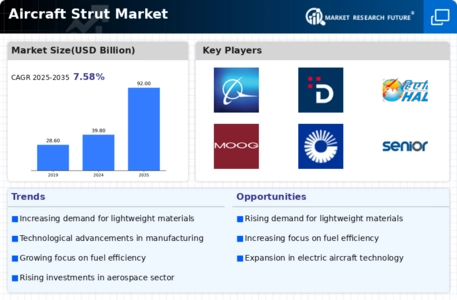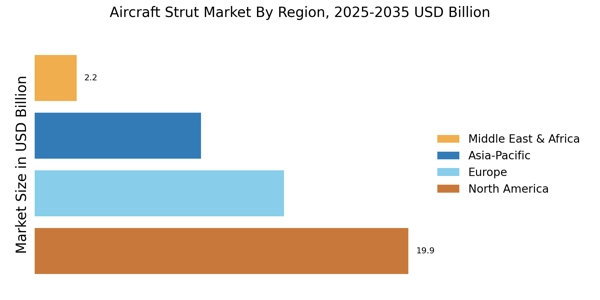The Aircraft Strut Market is currently characterized by a dynamic competitive landscape, driven by technological advancements and increasing demand for fuel-efficient aircraft. Major players such as Boeing (US), Airbus (FR), and Lockheed Martin (US) are at the forefront, each adopting distinct strategies to enhance their market positioning. Boeing (US) focuses on innovation in lightweight materials, which is crucial for improving fuel efficiency and reducing operational costs. Meanwhile, Airbus (FR) emphasizes regional expansion, particularly in Asia-Pacific, to tap into the growing demand for commercial aircraft. Lockheed Martin (US) is leveraging its defense contracts to diversify its portfolio, integrating advanced technologies into its strut designs, thereby enhancing performance and reliability. Collectively, these strategies contribute to a competitive environment that is increasingly centered around technological innovation and market responsiveness.
Key business tactics within the Aircraft Strut Market include localizing manufacturing and optimizing supply chains to enhance efficiency and reduce costs. The market structure appears moderately fragmented, with several key players exerting significant influence. This fragmentation allows for a variety of competitive strategies, as companies seek to differentiate themselves through innovation and operational excellence. The collective influence of these major players shapes market dynamics, fostering an environment where agility and responsiveness are paramount.
In August 2025, Boeing (US) announced a partnership with a leading materials science company to develop next-generation composite materials for aircraft struts. This strategic move is likely to enhance Boeing's competitive edge by enabling the production of lighter, more durable struts, which could significantly improve aircraft performance and fuel efficiency. Such innovations are essential as airlines increasingly prioritize sustainability and operational cost reductions.
In September 2025, Airbus (FR) unveiled its new manufacturing facility in Vietnam, aimed at localizing production of aircraft components, including struts. This facility is expected to streamline supply chains and reduce lead times, thereby enhancing Airbus's ability to meet the growing demand in the Asia-Pacific region. The establishment of this facility underscores Airbus's commitment to regional expansion and operational efficiency, positioning the company favorably against its competitors.
In July 2025, Lockheed Martin (US) secured a multi-year contract with the U.S. Department of Defense to supply advanced strut systems for military aircraft. This contract not only solidifies Lockheed Martin's position in the defense sector but also allows for the integration of cutting-edge technologies into their strut designs. The strategic importance of this contract lies in its potential to drive innovation and enhance the performance of military aircraft, thereby reinforcing Lockheed Martin's reputation as a leader in aerospace technology.
As of October 2025, the Aircraft Strut Market is witnessing trends that emphasize digitalization, sustainability, and the integration of artificial intelligence. Companies are increasingly forming strategic alliances to leverage complementary strengths, enhancing their competitive positioning. The shift from price-based competition to a focus on innovation, technology, and supply chain reliability is evident, suggesting that future differentiation will hinge on the ability to deliver advanced, sustainable solutions that meet evolving market demands.


















Leave a Comment